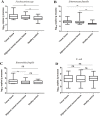Association of oncogenic bacteria with colorectal cancer in South China
- PMID: 27821805
- PMCID: PMC5348355
- DOI: 10.18632/oncotarget.13094
Association of oncogenic bacteria with colorectal cancer in South China
Abstract
To quantify Fusobacterium spp., Enterococcus faecalis (E.faecalis), Enterotoxigenic Bacteroides fragilis (ETBF), and Enteropathogenic Escherichia coli in colorectal cancer (CRC) patients and their possible association with CRC clinicopathogical features, we collected the resected tumors and adjacent normal tissues (N) from 97 CRC patients. 48 age- and sex-matched healthy controls (HC) were also recruited. Real-time PCR was used for bacterial quantification. The median abundance ofFusobacterium spp.(p < 0.001, vs. N; p < 0.01,vs. HC), E.faecalis (p < 0.05, vs. N; p < 0.01, vs. HC) and ETBF (p < 0.001, vs. N; p < 0.05,vs. HC) in tumor tissues was significantly higher than that detected in normal tissue and HC. E.faecalis was detected in 95.88% of tumors and 93.81% of adjacent tissues. Fusobacterium spp. was detected in 72.16% of tumors and 67.01% of adjacent tissues. The combined E.faecalis and Fusobacterium spp. were detected in 70.10% of tumors and 36.08% of adjacent normal tissues. All four bacteria were detected in 33.72% and 22.09% of paired tumor and adjacent normal tissues, respectively. E.faecalis and Fusobacterium spp. are enriched in both tumor and adjacent tissue of CRC patients when compared to HC, suggesting that it is possible to be previously undetected changes in the pathohistologically normal colon tissue in the proximity of the tumor.
Keywords: colorectal cancer; enterococcus faecalis; enteropathogenic escherichia coli; enterotoxigenic bacteroidesfragilis; fusobacterium spp..
Conflict of interest statement
None declared.
Figures


Similar articles
-
Quantitative profiling of colorectal cancer-associated bacteria reveals associations between fusobacterium spp., enterotoxigenic Bacteroides fragilis (ETBF) and clinicopathological features of colorectal cancer.PLoS One. 2015 Mar 9;10(3):e0119462. doi: 10.1371/journal.pone.0119462. eCollection 2015. PLoS One. 2015. PMID: 25751261 Free PMC article.
-
High frequency of enterotoxigenic Bacteroides fragilis and Enterococcus faecalis in the paraffin-embedded tissues of Iranian colorectal cancer patients.BMC Cancer. 2021 Dec 22;21(1):1353. doi: 10.1186/s12885-021-09110-x. BMC Cancer. 2021. PMID: 34937552 Free PMC article.
-
Bacterially-Associated Transcriptional Remodelling in a Distinct Genomic Subtype of Colorectal Cancer Provides a Plausible Molecular Basis for Disease Development.PLoS One. 2016 Nov 15;11(11):e0166282. doi: 10.1371/journal.pone.0166282. eCollection 2016. PLoS One. 2016. PMID: 27846243 Free PMC article.
-
Advances in drug resistance and resistance mechanisms of four colorectal cancer-associated gut microbiota.PeerJ. 2025 Jun 10;13:e19535. doi: 10.7717/peerj.19535. eCollection 2025. PeerJ. 2025. PMID: 40520636 Free PMC article. Review.
-
Gut microbiota imbalance and colorectal cancer.World J Gastroenterol. 2016 Jan 14;22(2):501-18. doi: 10.3748/wjg.v22.i2.501. World J Gastroenterol. 2016. PMID: 26811603 Free PMC article. Review.
Cited by
-
Correlation of gut microbiota with leukopenia after chemotherapy in patients with colorectal cancer.BMC Microbiol. 2023 Nov 17;23(1):349. doi: 10.1186/s12866-023-03067-6. BMC Microbiol. 2023. PMID: 37978347 Free PMC article.
-
The Interplay between Immunity and Microbiota at Intestinal Immunological Niche: The Case of Cancer.Int J Mol Sci. 2019 Jan 24;20(3):501. doi: 10.3390/ijms20030501. Int J Mol Sci. 2019. PMID: 30682772 Free PMC article. Review.
-
Differential Responses of Colorectal Cancer Cell Lines to Enterococcus faecalis' Strains Isolated from Healthy Donors and Colorectal Cancer Patients.J Clin Med. 2019 Mar 20;8(3):388. doi: 10.3390/jcm8030388. J Clin Med. 2019. PMID: 30897751 Free PMC article.
-
Microbiota, Inflammation and Colorectal Cancer.Int J Mol Sci. 2017 Jun 20;18(6):1310. doi: 10.3390/ijms18061310. Int J Mol Sci. 2017. PMID: 28632155 Free PMC article. Review.
-
Intratumoural pks+Escherichia coli is associated with risk of metachronous colorectal cancer and adenoma development in people with Lynch syndrome.EBioMedicine. 2025 Apr;114:105661. doi: 10.1016/j.ebiom.2025.105661. Epub 2025 Mar 29. EBioMedicine. 2025. PMID: 40158390 Free PMC article.
References
-
- Di Bisceglie AM, Goodman ZD, Ishak KG, Hoofnagle JH, Melpolder JJ, Alter HJ. Long-term clinical and histopathological follow-up of chronic posttransfusion hepatitis. Hepatology. 1991;14:969–74. doi. - PubMed
-
- Kiyosawa K, Sodeyama T, Tanaka E, Gibo Y, Yoshizawa K, Nakano Y, Furuta S, Akahane Y, Nishioka K, Purcell RH, et al. Interrelationship of blood transfusion, non-A, non-B hepatitis and hepatocellular carcinoma: analysis by detection of antibody to hepatitis C virus. Hepatology. 1990;12:671–5. - PubMed
MeSH terms
Substances
LinkOut - more resources
Full Text Sources
Other Literature Sources
Medical
Miscellaneous

